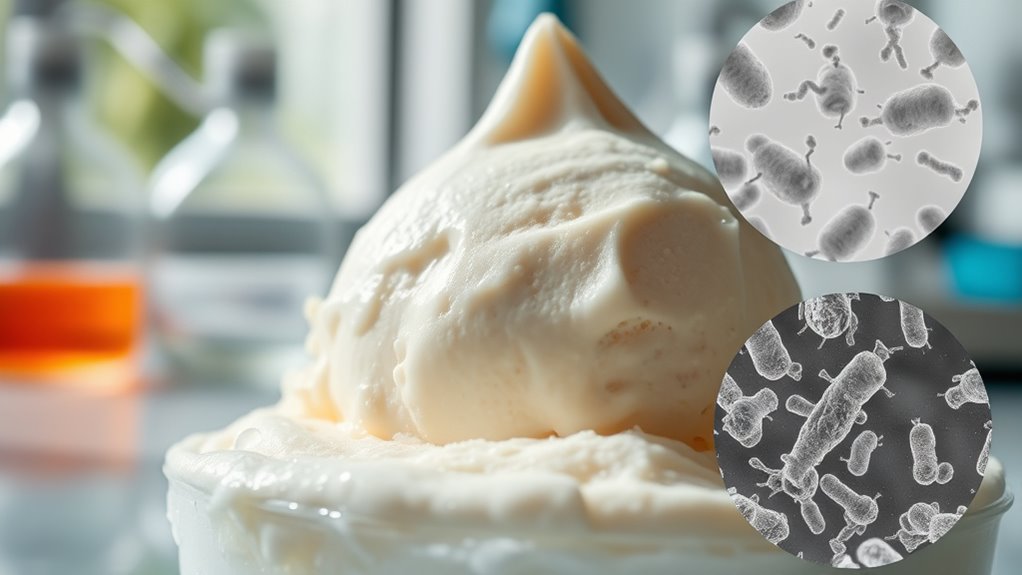Ice cream can harbor Listeria monocytogenes and other bacterial risks that may lead to serious illness. If you’re among high-risk groups—like pregnant women or the elderly—you need to be especially cautious. Symptoms can start mild but may escalate considerably if not treated. Always check for recalls, maintain proper freezing temperatures, and use clean utensils. Understanding these risks is crucial for your health. There’s more to learn about safe practices and prevention strategies.
Key Takeaways
- Listeria monocytogenes can survive freezing temperatures, posing significant contamination risks in ice cream products.
- High-risk groups, including pregnant women and the elderly, are particularly vulnerable to severe listeria infections.
- Symptoms of listeriosis may take weeks to manifest, complicating the identification of contamination sources.
- Food safety regulations and inspections are essential for detecting pathogens and preventing listeria outbreaks in dairy products.
- Consumers should practice safe handling, monitor for recalls, and ensure proper storage temperatures to minimize bacterial risks.
Understanding Listeria: A Hidden Threat in Ice Cream

When it comes to enjoying a scoop of ice cream, many don’t realize that Listeria monocytogenes could be lurking within. This bacterium can survive and multiply in freezing conditions, making ice cream products particularly susceptible to contamination.
If ingested, listeria can lead to severe illness, especially in vulnerable populations like pregnant women and the elderly. Symptoms might start as mild flu-like signs but can escalate to severe complications, such as meningitis or miscarriage.
Listeria can cause serious illness, particularly in pregnant women and the elderly, leading to complications like meningitis or miscarriage.
The incubation period for listeria is extensive, ranging from 3 to 70 days, which complicates recognizing the source of infection linked to your favorite ice cream.
To minimize risk, food safety practices and regular inspections of production facilities are essential in preventing listeria contamination.
High-Risk Populations: Who Should Be Concerned?

If you’re pregnant, elderly, or have a weakened immune system, you should be particularly cautious about listeria in ice cream.
Symptoms like fever and headache mightn’t seem severe for healthy adults, but they can pose serious risks to vulnerable groups.
It’s essential to recognize these risks and stay informed to protect yourself and others.
Vulnerable Groups Overview
Certain groups face a heightened risk of severe illness from listeriosis, making it essential for them to be aware of food safety, especially regarding ice cream.
Vulnerable populations like pregnant women are particularly at risk, being 20 times more likely to contract listeria, which can lead to devastating outcomes such as miscarriage or stillbirth.
The elderly and individuals with weakened immune systems or chronic illnesses also face a higher risk, with listeriosis potentially leading to hospitalization and a mortality rate of up to 30%.
While healthy individuals might experience milder symptoms, it’s critical for at-risk populations to remain vigilant.
With around 1,600 cases and 260 fatalities annually in the U.S., awareness of listeria-related risks is essential for protecting your health.
Symptoms to Watch For
How can you recognize the symptoms of listeriosis, especially if you’re among the high-risk populations? It’s vital to stay vigilant. Here are some key symptoms to watch for:
| Symptoms | High-Risk Populations |
|---|---|
| Fever | Pregnant women |
| Muscle aches | Elderly individuals |
| Gastrointestinal symptoms | Individuals with weakened immune systems |
Listeria infection can lead to severe consequences, particularly for pregnant women, who are at a higher risk. While healthy individuals might experience mild symptoms, vulnerable populations can suffer from more severe illness. If you notice fever, muscle aches, or gastrointestinal symptoms after potential exposure, seek medical advice promptly. Food safety is important for everyone, especially those in high-risk categories.
Symptoms of Listeriosis: What to Watch For

When it comes to listeriosis, it’s essential to recognize the early symptoms, which often include fever and muscle aches.
If you or someone you know begins to experience severe symptoms like confusion or a stiff neck, it’s important to seek medical attention immediately.
Vulnerable populations, especially pregnant women and the elderly, should be particularly vigilant about these signs.
Common Early Symptoms
What should you watch for if you suspect listeriosis? Common early symptoms can include fever, muscle aches, and diarrhea. These symptoms can appear anywhere from a few days to two months after exposure to listeria through contaminated food. Pregnant women are particularly at risk, as they might experience mild symptoms but could face severe consequences like miscarriage.
| Symptom | Description |
|---|---|
| Fever | Elevated body temperature |
| Muscle Aches | Discomfort or pain in muscles |
| Diarrhea | Loose or watery stools |
| Gastrointestinal Issues | Nausea or abdominal pain |
| Incubation Period | Symptoms can take 3 to 70 days |
Stay alert for these signs, especially if you’re in a high-risk group!
Severe Health Impacts
Although early symptoms of listeriosis might seem mild, they can quickly escalate into severe health impacts if left unaddressed. A listeria infection can lead to high fever, severe headaches, stiff necks, and confusion.
Food safety experts warn that the mortality rate for this food borne illness can reach 30%, particularly among elderly people and those with weakened immune systems. Pregnant women face even graver risks, as contaminated food can result in miscarriages and stillbirths.
Newborns may display symptoms like irritability and vomiting, indicating the severe consequences of listeria. Recognizing these symptoms early is vital to prevent further complications and guarantee timely medical intervention.
Stay vigilant and prioritize food safety to protect yourself and others.
Vulnerable Populations at Risk
Certain groups, such as pregnant women, the elderly, and individuals with weakened immune systems, face a heightened risk of listeriosis, making it essential to recognize the early symptoms. Listeria can lead to severe illness, especially in these vulnerable populations.
| Symptoms | Pregnant Women | Elderly/Newborns |
|---|---|---|
| Fever | Yes | Yes |
| Muscle Aches | Yes | Yes |
| Gastrointestinal Issues | Yes | Yes |
| Neurological Symptoms | Rare | Yes |
Pregnant women are 20 times more likely to contract listeriosis, risking miscarriage or stillbirth. Newborns may show irritability and fever. Early detection is vital for preventing severe outcomes.
Historical Context: Ice Cream Outbreaks and Lessons Learned

Ice cream has a rich history, but it’s also marred by significant health risks that have emerged from various outbreaks over the years.
Here are some key events that shaped our understanding of these risks:
- 1993 Salmonella Outbreak: Schwan’s Ice Cream linked to 224,000 illnesses.
- 2015 Listeria Outbreak: Blue Bell Creameries resulted in 10 hospitalizations.
- Big Olaf’s Investigation: 16 of 17 flavors tested positive for Listeria, causing 23 infections across 10 states.
- Delayed Symptoms: Listeria symptoms can take from a few days to 70 days to appear.
These outbreaks underscore the dangers of contamination and the need for stringent food safety measures. Additionally, ice cream’s high sugar and fat content can exacerbate health issues, making it essential to prioritize safety in production practices.
Regulatory actions have evolved, emphasizing the importance of preventing future infections and protecting public health.
Food Safety Inspections: The Role of Regulatory Agencies

The history of ice cream outbreaks highlights the ongoing need for vigilance in food safety practices. Regulatory agencies, like the FDA, play a vital role through food safety inspections that detect pathogens such as Listeria monocytogenes.
These inspections involve monitoring equipment and finished products to guarantee compliance with food safety regulations, identifying potential contamination risks. For instance, the FDA’s findings led to a significant voluntary recall of over 60 Totally Cool ice cream items to protect consumer health.
The presence of Listeria underscores the importance of federal oversight in preventing public health emergencies. Ongoing investigations by regulatory agencies further stress the need for stringent safety practices and regular inspections to mitigate risks associated with foodborne pathogens like Listeria.
Prevention Strategies: Keeping Ice Cream Safe

To guarantee your ice cream remains safe and delicious, it’s essential to follow strict prevention strategies throughout its production and handling. Here are some key steps you can take:
Ensuring safe and delicious ice cream requires strict prevention strategies during production and handling.
- Maintain refrigeration temperatures: Keep ice cream at consistent freezing temperatures below 0°F (-18°C) to prevent listeria growth.
- Practice proper handling: Always use clean utensils and avoid leaving ice cream out at room temperature for more than 2 hours.
- Stay informed about recalls: Regularly check for recall announcements from the FDA to stay updated on potential listeria concerns.
- Choose wisely: Pregnant women and those with weakened immune systems should avoid raw or unpasteurized dairy products in ice cream to reduce the risk of contamination.
Following these food safety measures will help you enjoy your ice cream worry-free!
Consumer Guidance: What to Do If You Have Recalled Products

If you find yourself with ice cream products that have been recalled, it’s important to act quickly to guarantee your safety. First, check the packaging for date and plant codes to identify affected products. Return any contaminated items to the place of purchase for a full refund.
| Action to Take | Additional Information |
|---|---|
| Return affected products | Full refund available |
| Dispose of recalled items | Prevent health risks from listeria |
| Contact Totally Cool | Call (410) 363-7801 or email regulatory@totallycoolicecream.com |
Staying informed about food safety recalls is essential. By following these steps, you can protect your health and minimize the risks associated with listeria contamination.
Frequently Asked Questions
What Bacteria Can Be in Ice Cream?
Ice cream can harbor several types of bacteria that pose health risks.
You might find Salmonella, often linked to raw eggs, and E. coli, which can come from contaminated dairy products. These bacteria can thrive in ice cream if proper hygiene isn’t maintained during production.
It’s crucial to verify that the ingredients used are pasteurized and safe to minimize your risk of foodborne illness while enjoying your favorite frozen treat.
What Are 4 Different Types of Food That Is Associated With Listeria?
When you think about foods associated with listeria, consider deli meats, especially hot dogs, which can get contaminated during processing.
Soft cheeses made from unpasteurized milk are another risk, as they can harbor harmful bacteria.
Refrigerated smoked seafood is also concerning if it’s not handled properly.
Finally, ready-to-eat salads and pâtés can pose risks due to potential cross-contamination.
Always be cautious and follow safe food handling practices to minimize exposure.
What Bacteria Is in Ice Cream That Causes Food Poisoning?
When you enjoy ice cream, you mightn’t realize it can harbor harmful bacteria. Listeria monocytogenes is a significant concern, as it can lead to food poisoning and thrive in cold environments.
Additionally, Salmonella and E. coli are other bacteria that can also cause foodborne illness from contaminated ice cream. Always check for proper handling and storage, especially if you’re serving it to vulnerable individuals who are more susceptible to these infections.
Which Bacteria Is Known to Cause Listeriosis and Common on Dairy Products?
They say, “An ounce of prevention is worth a pound of cure.”
When it comes to dairy products, the bacterium you need to watch out for is Listeria monocytogenes. This sneaky bacterium can thrive in cold environments, making it a common risk in unpasteurized dairy.
If you’re part of a vulnerable group, like pregnant women or the elderly, it’s especially vital to stay informed about this potential threat in your food choices.
Conclusion
In the icy domain of ice cream, lurking dangers like Listeria can turn a delightful scoop into a nightmare! If you’re among the high-risk crowd, stay vigilant—don’t let a creamy cone become a ticking time bomb! Always check for recalls and practice safe handling. Remember, one spoonful could release a whirlwind of symptoms, so treat your frozen treats with respect. Keep your freezer a fortress against bacterial foes, and savor your ice cream without fear!









